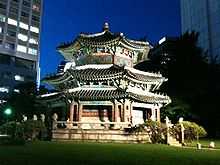Wongudan
| Wongudan | |
 The Hwangungu in 2009 | |
| Korean name | |
|---|---|
| Hangul | 원구단 |
| Hanja |
圜丘壇/圓丘壇 /祭天壇 |
| Revised Romanization | Won(-)gudan |
| McCune–Reischauer | Wŏn'gudan |
Wongudan Altar, located in Jung-gu, Seoul, South Korea, was built in 1897 to serve as a site for the performance of the rite of heaven. The site was also known by other names, such as Hwangudan (환구단, 圜丘壇), Jecheondan (제천단, 祭天壇) and Wondan (원단, 圜壇).[1] Wongudan was designated South Korea's Historic Site No. 157 on July 15, 1967.
The rite of Heaven was performed during the pre-Three Kingdoms period. During the Goryeo Dynasty, King Seongjong was the first of the Goryeo kings to perform the rite of heaven, designed to ensure a bountiful harvest. King Seongjong standardized the Wonguje rituals. During the Goryeo Dynasty, the practice was abolished.
King Sejo of the Joseon Dynasty briefly restarted the rite but stopped the practice in the tenth year of his reign in 1464.
The ritual was restarted again when King Gojong proclaimed the Korean Empire in 1897, but it was subsequently abolished by the Japanese colonial government in 1910.
Wongudan was built in 1897. The site of the complex sat between Namsan and Bukhansan, and was considered highly auspicious by geomancers. The altar complex was also designed to mimic natural elements such as the sun and moon. It was a three-story altar made of granite and was used for animal sacrifice. The top center of the altar held a conical yellow-roofed building. The altar was destroyed by the Japanese in 1913. Today, the Hwanggungu (Yellow Palace Shrine), a three-storied octagonal shrine built in 1899, remains along with three plaster drums with dragon decorations, and a gate. The Hwangungu was built on the north side of the altar complex was designed for the worshiping of the Heaven and respecting Taejo, the founder of the Joseon Dynasty. The Gocheonje ritual was revived in 2002 and will be performed annually as a revival of Korean cultural heritage.
The imperial Japanese built the Railroad Chosun Hotel in the area where they had demolished Wongudan Altar. In 1968, that hotel was demolished and the Westin Chosun Hotel was built in its place. The Hwangungu still stands in the hotel complex today and although it is not a very well known tourist site, it is quite popular with the guests of the hotel.
Gallery
-
The three-story Hwangungu is the largest altar of the Wongudan Altar that remains.
-

Wongudan in 1925.
-

The Wongudan in 2011.
See also
- Temple of Heaven
- Seoul Sajiktan
- Korean Empire
References
External links
- Cultural Heritage Online: Wongudan
- Seoul, Jung-gu Culture & Tourism
- Asian Historical Architecture: Wongudan Altar
- http://san-shin.org/TOH-1.html
- An image of the old Wongudan Altar
Coordinates: 37°33′54.19″N 126°58′47.46″E / 37.5650528°N 126.9798500°E
